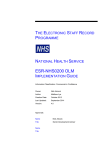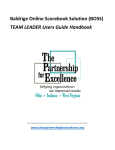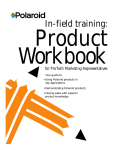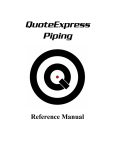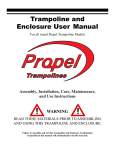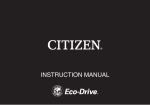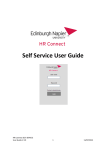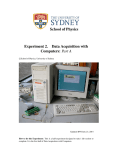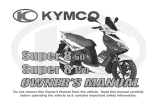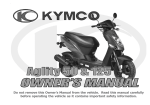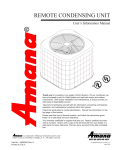Download Safety Program Document
Transcript
The BP Group EH&S Program Environmental Health & Safety Program 1 The BP Group EH&S Program Table of Contents 1) Statement of Corporate Policy 2) OSHA Recordkeeping 3) Emergency Response and Action Plan 4) Substance Policy and Testing 5) Employee Disciplinary Procedures 6) Illness and Injury Case Management 7) Safety Meetings 8) Driver Qualification and MVR Criteria 9) Fall Protection 10) Personal Protective Equipment Policies 11) Refrigerant Program and Compressed Gas Cylinders 12) LOTO Policy and Procedure 13) Electrical Safety Procedures 14) Hand and Power Tool Safety 15) Hazard Communications Globally Harmonized 2 The BP Group EH&S Program The BP Group Corporate Safety Policy Statement We at The BP Group recognize our employees as our most valued asset. As a result we have developed and implemented safety policies, procedures and training designed to identify, reduce and eliminate sources of worker injury, vehicle crashes and liability loss. We understand that not only do our industry regulators and Insurance carriers require a culture of proactive Environmental Health and Safety, but that our customers, who are our reason for being, deserve no less. To this end, The BP Group has implemented a strict progressive disciplinary program following OSHA guidelines to enforce employee compliance with our EH&S standards. All employees whose responsibilities entail job site visits receive 10 hours OSHA Training every five years as per NYC Department of Buildings guidelines. All Managers and Supervisors receive baseline 30 hours OSHA Training in recognition of the additional knowledge they require to fulfill their responsibilities to our overall safety efforts. Each employee who conducts customer visits is required to attend The BP Group monthly safety meeting. All employees must agree to cooperate in full with our company safety standards in order to assure a safe and healthful workplace while maintaining excellent customer relationships. John Fanneron President 3 The BP Group EH&S Program OSHA Recordkeeping The BP Group will maintain separate Injury and Illness Logs for BP Air Conditioning and BP Mechanical to align with the separate worker compensation policies for these two corporate entities. Summary report for BP Mechanical will be posted from February 1 to April 1 for the preceding years losses in the second floor lunch room. The Summary for BP Air for the same period will be posted on the Bulletin Board located on the first floor beneath the mezzanine level opposite the base of the stairs. 4 The BP Group EH&S Program Emergency Response and Action Plan The BP Group has developed an Emergency Evacuation Plan for its state of the art facility in Glendale, NY. Evacuation diagrams are posted. Baseline training of all employees with new hire orientation training on these procedures is ongoing. In the event of a Fire or Medical Emergency 911 is called. A company spokesperson has been designated to respond to any media inquiries concerning any Liability, Worker or Vehicle loss. 5 The BP Group EH&S Program Substance Policy and Testing The BP Group has a zero tolerance policy for alcohol and drug use in the workplace. The company has used the services of our Labor Union to conduct baseline substance testing on our staff. Use of the Employee Assistance Program coordinated through our Labor Union is made available to any positive test result. Upon successful completion of the EAP, the company will consider returning an employee to safety sensitive work responsibilities. Management has been trained to identify Reasonable Suspicion indicators of substance abuse and in that event mandatory testing to confirm positive results are conducted. Refusal of an employee to take a test is accepted as a positive test result. As The BP Group has no Vehicles that require a CDL to operate it is exempt from DOT Substance Testing requirements. 6 The BP Group EH&S Program Employee Disciplinary Procedures BP proactively seeks to prevent worker injuries and vehicle crashes on a pre-injury or crash basis. We recognize that identifying bad safety behaviors regardless of loss consequence is vital to loss prevention. In this spirit, BP has modeled its Progressive Disciplinary procedures from OSHA guidelines and applies them to both Worker Safety and Fleet Safety Compliance. The first employee incident of failing to comply with the policies and procedures set forth in this Program results in a formal warning and re-training in the particular compliance issue cited. The second incident will result in a formal probation accompanied with re-training. The third incident will result in termination of the employee in a worker safety issue or loss of operating a company vehicle regarding fleet safety issues. 7 The BP Group EH&S Program Employee Illness and Injury Case Management All work related illness and injuries are reviewed by the company safety committee consisting of the President, Safety Consultant and Office Manager. Root causal analysis is completed for each incident and corrective actions designed to prevent recurrence of loss is implemented and followed upon for completion. Employees are informed of any preventable actions on their part. The company uses the OSHA guidelines of progressive discipline to effectively retrain employees on safety policies and procedures. Warning, probation and termination steps are built into this process. Employees who are injured are monitored closely by management in concert with our insurance company representatives and attending employee physicians with the goal of expediting a safe and productive early return to work. Whenever possible, the company will provide light duty or Temporary Work Assignments for injured employees. Our goal is to control worker compensation costs while helping our injured employees to return as soon as medically allowed to a safe work environment. 8 The BP Group EH&S Program Safety Meetings The BP Group conducts safety meeting on three Monday afternoons each month. All employees who conduct any off corporate location customer visits are mandated to attend one of these meetings. Each meeting addresses topics of OHA and Driver Safety. These are short duration meetings approximately half an hour in duration conducted by our Corporate Safety Consultant. They are intended to maintain a high level of safety awareness year round, hence the monthly frequency. Attendance records are maintained and attendance spread sheets developed to monitor compliance of all personnel to maintain a strong level of employee participation. Topics are selected based on recognized hazards of our industry and our companies actual loss experience as a lesson learned approach to discussing vital safety issues. 9 The BP Group EH&S Program Driver Qualification/ MVR Criteria The following criteria has been adopted as a management tool intended to assure that well qualified employees and new hire drivers will be authorized to operate company vehicles. Motor Vehicle Records (MVR’s) will be ordered and reviewed by management a minimum of once a year on all current employee drivers. MVR’s will be reviewed quarterly on all drivers with more than two moving violations. MVR’s will be reviewed prior to hire for all new hire applicants. Failure to meet the criteria will serve to prohibit new hires from being assigned the use of company vehicles. It will result in existing drivers being mandated to complete a Department of Motor Vehicle approved Defensive Driver Training course within sixty (60) days of notice by management. Personal Use of BP Vehicles is limited as per corporate policy. In no event will a nonemployee under the age of 21 years be authorized to operate a company vehicle. The nonemployee MVR will be reviewed by BP management and must meet these same minimal criteria. Three (3) years driving experience Current and valid driver’s license No Motor Vehicle record of reckless driving, reckless homicide, or involuntary manslaughter. No conviction of driving under the influence of drugs and/or alcohol within the past three (3) years. No record of more than three (3) moving violations during the prior three (3) years. No record of more than one (1) at fault accident in the prior two (2) years. I reviewed and understand the above policy for the right to operate a BP Air Conditioning company vehicle. Employee Signature ___________________________ Print Name ___________________________ Date __________ 10 The BP Group EH&S Program Fall Protection All employees have been provided training on a baseline basis regarding the safe use, type and selection of portable ladders used on the job sites. Maintaining three points of contact while climbing or descending from ladders is a mandatory company policy. Use of tool belts to free hands for three point contact is required. All work above six feet off the ground requires Personal Fall Arrest Systems in the form of harness belts and lanyards tie off to prevent injury. All employees have received training in these Fall Protection procedures. Good Housekeeping practices and prework visual inspections to assure that work areas are free of trip/fall hazards is also a required component of this procedure. 11 The BP Group EH&S Program Personal Protective Equipment Policies Introduction The purpose of the Personal Protective Equipment Policies is to protect the employees of BP from exposure to work place hazards and the risk of injury through the use of personal protective equipment (PPE). PPE is not a substitute for more effective control methods and its use will be considered only when other means of protection against hazards are not adequate or feasible. It will be used in conjunction with other controls unless no other means of hazard control exist. Personal protective equipment will be provided, used, and maintained when it has been determined that its use is required to ensure the safety and health of our employees and that such use will lessen the likelihood of occupational injury and/or illness. This section addresses general PPE requirements, including eye and face, head, foot and leg, hand and arm, body (torso) protection, and protection from drowning. Separate programs exist for respiratory protection and hearing protection as the need for participation in these programs is established through industrial hygiene monitoring. The BP Personal Protective Equipment Policies includes: Responsibilities of supervisors and employees Hazard assessment and PPE selection Employee training Cleaning and Maintenance of PPE 12 The BP Group EH&S Program Responsibilities BP Management is responsible for the development, implementation, and administration of BP PPE policies. This involves: Conducting workplace hazard assessments to determine the presence of hazards which necessitate the use of PPE Selecting and purchasing PPE Reviewing, updating and conducting PPE hazard assessments whenever a job changes, new equipment is used, there has been an accident, a supervisor or employee request it or at least once every year Maintaining records on hazard assessments Maintaining records on PPE assignments and training Providing training, guidance and assistance to supervisors and employees on the proper use, care and cleaning of approved PPE Periodically re-evaluating the suitability of previously selected PPE Reviewing, updating and evaluating the overall effectiveness of PPE use, training and policies Supervisors Supervisors have the primary responsibility for implementing and enforcing PPE use and policies in their work area. This involves: Providing appropriate PPE and making it available to employees Ensuring that employees are trained on the proper use, care and cleaning of PPE Ensuring that PPE training certification and evaluation forms are signed and given to Sean Libby Ensuring that employees properly use and maintain their PPE and follow BP PPE policies and rules 13 The BP Group EH&S Program Notifying BP management and the Safety Person when new hazards are introduced or when processes are added or changed Ensuring that defective or damaged PPE is immediately disposed of and replaced Employees The PPE user is responsible for following the requirements of the PPE policies. This involves: Properly wearing PPE as required Attending required training sessions. Properly caring for, cleaning, maintaining and inspecting PPE as required, following BP PPE policies and rules Informing the supervisor of the need to repair or replace PPE Employees who repeatedly disregard and do not follow PPE policies and rules will be subject to the BP Progressive Disciplinary Program. First violation a written warning and re-training, a second violation shall result in Formal Written probation and re-training, a third violation shall result in employee termination. Procedures Hazard Assessment for PPE Supervisors will conduct a walk-through survey of each work area to identify sources of work hazards. Each survey will be documented using the Hazard Assessment Certification Form, which identifies the work area surveyed, the person conducting the survey, findings of potential hazards and date of the survey. Sean Libby will keep the forms in the Corporate HQ in Freeport, NY. Supervisors will conduct, review and update the hazard assessment for PPE whenever: 14 The BP Group EH&S Program A job changes New equipment or process is installed There has been an accident, a supervisor or employee request it or at least every year Any new PPE requirements that are developed will be added into ICACS written accident prevention program Selection of PPE Once the hazards of a workplace have been identified, ICACS will determine if the hazards can first be eliminated or reduced by methods other than PPE, i.e., methods that do not rely on employee behavior, such as engineering controls. If such methods are not adequate or feasible, then Sean Libby will determine the suitability of the PPE presently available; and as necessary, will select new or additional equipment which ensures a level of protection greater than the minimum required to protect our employees from the hazards. Care will be taken to recognize the possibility of multiple and simultaneous exposure to a variety of hazards. Adequate protection against the highest level of each of the hazards will be recommended for purchase. All personal protective clothing and equipment will be of safe design and construction for the work to be performed and will be maintained in a sanitary and reliable condition. Only those items of protective clothing and equipment that meet NIOSH or ANSI (American National Standards Institute) standards will be procured or accepted for use. Newly purchased PPE must conform to the updated ANSI standards which have been incorporated into the PPE regulations, as follows: Eye and Face Protection ANSI Z87.1-1989 Head Protection ANSI Z89.1-1986 Foot Protection ANSI Z41.1-1991 15 The BP Group EH&S Program Hand Protection (There are no ANSI standards for gloves, however, selection must be based on the performance characteristics of the glove in relation to the tasks to be performed.) Affected employees whose jobs require the use of PPE will be informed of the PPE selection and will be provided PPE by ICACS at no charge. Careful consideration will be given to the comfort and proper fit of PPE in order to ensure that the right size is selected and that it will be used. Training Any worker required to wear PPE will receive training in the proper use and care of PPE before being allowed to perform work requiring the use of PPE. Periodic retraining will be offered to PPE users as needed. The training will include, but not necessarily be limited to, the following subjects: When PPE is necessary to be worn What PPE is necessary How to properly don, doff, adjust and wear PPE The limitations of the PPE The proper care, maintenance, useful life and disposal of the PPE After the training, the employees will demonstrate that they understand how to use PPE properly or they will be retrained. Training of each employee will be documented using the Personal Protective Equipment Training Class attendance sheets and the PPE section documented in the BP 10 HR OSHA Training Class and kept on file. The document certifies that the employee has received and understood the required training on the specific PPE he/she will be using. 16 The BP Group EH&S Program Refrigerant Program and Compressed Gas Cylinders The U.S. Environmental Protection Agency (EPA) cites environmental preservation as its motivation for the high degree of regulation in the air conditioning industry. Following EPA refrigerant regulations responsibly will contribute to the reduction of an environmental threat and protect organizations from civil penalties of up to $32,500 per day per violation and criminal penalties of up to five years imprisonment. For these reasons, it is important for all employees and outside contractors working with refrigerants follow organizations’ written EPA policy and procedures. Well-defined procedures, appropriate equipment and sufficient knowledge of refrigerants will reduce accidents and injuries on the job. Training for Compliance Although mandatory, safety and training are only parts of compliance. The EPA recommends that every organization designate a facility refrigerant compliance manager and implement a refrigerant compliance management plan. Producing a program that outlines organization-specific, written refrigeration regulations is the first step to effective compliance. BP’s program describes how EPA regulations fit into our organization’s work processes. The program also defines BP’s specific policies and procedures for refrigerant handling, from purchase through final disposal. Training is required within our organization to successfully implement an EPA refrigerant-management compliance program. The training program ensures that everyone affected receives a copy of the compliance program and any other information needed to ensure success. Employees sign a statement of understanding that compliance is a condition 17 The BP Group EH&S Program of their employment, and managers include these requirements in contractor agreements. To maintain ongoing compliance, managers schedule regular compliance update training. This step reinforces the importance of compliance and further demonstrates BP’s intent to comply. Integrating Safety Section 608 of the Clean Air Act Amendments of 1990, as well as more recently proposed EPA amendments, require that technicians follow specific procedures while maintaining, servicing, repairing or disposing of airconditioning or refrigeration equipment. Technicians can prevent injuries and costly mistakes by consistently following defined procedures and using common sense when handling refrigeration equipment. Taking simple precautions can be a substantial leap toward industry-wide safety. Among the more obvious practices that should become habit for refrigerant technicians are these: First, returnable cylinders must meet U.S. Department of Transportation (DOT) specifications and are characterized by a combined liquid/vapor valve located at the top. A returnable cylinder must never be filled above 80 percent of the container’s volume. If cylinders will be exposed to temperatures above 130 degrees, technicians should not fill them more than 60 percent. Hydrostatic pressure can be deadly in an overfilled refrigerant container. While over-pressure safety devices provide some level of safety, they do not eliminate risk. An opened valve can spew refrigerant, or the entire tank might rupture with extreme violence. Second, technicians should weigh and inspect cylinders carefully before filling. They should also: 18 The BP Group EH&S Program Not use cylinders that are dented, rusted, gouged or damaged in any way Examine the valve assembly for leakage, damage or tampering Handle cylinders carefully Store refrigerant cylinders in a vertical position with their valves at the top Become familiar with all pieces of recovery equipment Apply all methods and instruction prescribed by the system’s manual every time they use the equipment. Disposable cylinders, which are constructed of common steel, can oxidize and become weakened by rust. As a result, their wall and seams no longer can tolerate pressure or contain gases. Technicians should discard rusted containers because they can never be used for recovery or refilling. To prevent corrosion, technicians should store containers in dry locations. Cylinders with residual refrigerant should not be allowed to sit at a job site because saturated vapor pressure will form if even the smallest amount of liquid is present. Before discarding a container, technicians should recover any remaining refrigerant per EPA recovery efficiencies. Third, technicians should collect used refrigerant in DOT-approved, refillable cylinders or drums, as appropriate, painted gray with the top shoulder portion painted yellow. They need to label the cylinder or container with a DOT four-by-four green, diamond-shaped, nonflammable gas label. Finally, technicians must fill drums to allow vapor space equal to at least 10 percent of the drum height between the top of the liquid and the drum top. Refillable cylinders must be retested and recertified every five years, and the test date must be stamped on the cylinder shoulder. Retesting by visual inspection alone is not permitted. 19 The BP Group EH&S Program Transporting and Transferring In transporting used refrigerant, technicians need to clearly label its container with a DOT classification tag. When moving a cylinder, they must ensure that it is firmly strapped onto an appropriate wheeled device. Never roll a cylinder on its base or lay it down to roll it. Use a forklift truck to move half-ton containers of refrigerant. When transferring refrigerant from containers or equipment, it is mandatory to avoid contamination or venting to the atmosphere. Containers must be the correct type and color and properly marked. Any time a container or system undergoes the transfer of refrigerant, the technician must check it for refrigerant type, cleanliness and oils used. Also, the container used for holding transferred refrigerant must be evacuated, and under no circumstances should workers mix different refrigerants. Technician Protection Chlorofluorocarbons and hydrochlorofluorocarbons are heavier than air and will replace air in a confined space. This situation can lead to possible asphyxiation for anyone working in the space. Oxygen starvation is the leading cause of death in accidents involving a refrigerant. Technicians must take extreme care to avoid direct ingestion of refrigerant vapors. If a spill occurs, they will need to put on a self-contained breathing apparatus or evacuate the area until it has been properly ventilated. Also, careless handling of cylinders can result in sudden releases of refrigerant, which can cause frostbite, skin damage or blindness. To avoid these circumstances, workers should wear safety glasses with side shields or a full-face shield, safety shoes, hard hat, long pants, gloves and a longsleeved shirt. 20 The BP Group EH&S Program Workers can prevent accidents around hoses and extension cords by using proper barriers and signs. Use top-quality, properly attached hoses and lines, place them where risk is minimal, and inspect hose seals frequently. Wear butyl-lined gloves and safety glasses when working with hoses. Technicians can also enhance safety by: Ensuring that all power is disconnected and disabled to any equipment requiring recovery Locking out disconnects with approved lockout devices Opening valves slowly and knowing in advance if liquid vapor will be released Not plugging pressure-relief devices Never applying direct heat to a closed system that contains refrigerant. Finally, installing refrigerant vapor sensors, an adjoining alarm system, ventilation piping leading from the purge units to the outside air and ventilation exhaust fans can increase the safety of a system. 21 The BP Group EH&S Program Lockout/Tagout The LOTO procedure requires the electrical circuit that powers the equipment to be shut off and the panel pad lock closed to prevent the circuit from being reactivated while the equipment is under maintenance or installation. In addition, the equipment itself must be tagged out of service until the machine guards have been reinstalled, making the machine again safe for employee use. Employees will be required to view the MCAA Electrical Arc Flash safety video and OSHA prevention protocols. All employees of The BP Group have received training in these policies and procedures as well as the necessary equipment to remain safe on the job. Lockout/Tagout kits have been provided to each employee who will be held to comply with Industrial Cooling procedures. OSHA Progressive Disciplinary procedures will be enforced by BP management to assure safety and health compliance. 22 The BP Group EH&S Program ELECTRICAL SAFETY PURPOSE Electricity is a serious work place hazard, capable of causing both employee injuries (shocks, electrocution, fires and explosions) as well as serious property damage. By providing maintenance personnel with proper training in safe electrical work practices, The BP Group hopes to reduce the risk of such incidents. RESPONSIBILITIES BP management is responsible for providing employee safety training, conducting electrical safety inspections, correcting all electrical safety hazards and ensuring that all new electrical equipment and components comply with codes and regulations. Employees are responsible for the immediate reporting of electrical safety hazards, for not working on electrical equipment without proper training and authorization, and for inspecting equipment prior to using it. DEFINITIONS Qualified worker: An employee who is trained and authorized to perform work on electrical equipment and components. Unqualified worker: An employee who has not been trained or authorized to perform electrical work. HAZARD CONTROL The following control methods will be used to prevent occurrence of electricity-related incidents: 23 The BP Group EH&S Program Engineering Controls All electrical distribution panels, breakers, disconnects, switches and junction boxes must be completely enclosed Water-tight enclosures must be used if any of these components could possibly be exposed to moisture Structural barriers must be used to prevent accidental damage to electrical components Conduits must be supported for their entire length and nonelectrical attachments to conduits are prohibited Non-rigid electrical cords must have strain relief wherever necessary Administrative Controls Only trained, authorized employees may repair or service electrical equipment Contractors must be licensed to perform electrical work Physical barriers must be used to prevent unauthorized persons from entering areas where new installation or repair of electrical components or equipment is being performed Only authorized employees may enter electrical distribution rooms All electrical control devices must be labeled properly Senior facility management must authorize any work on energized electrical circuits Work Practice Controls Employees covered under this policy must wear electrically rated safety shoes or boots Use only tools that are properly insulated 24 The BP Group EH&S Program Non-conductive gloves will be available for work on electrical equipment Electrical-rated matting will be placed in front of all electricitydistribution panels ELECTRICAL EQUIPMENT INSPECTIONS Inspect all electrical equipment for hazards that could cause employee injury or death. Consider the following factors when determining the safety of the equipment: Suitability for the intended use Proper insulation Heating effects under conditions of use Arcing effects Classification by type, size, voltage, current capacity and intended use PERSONAL PROTECTIVE EQUIPMENT The BP Group will provide personal protective equipment for use by employees working in areas where they could be exposed to electrical hazards. Employees are required to observe the following procedures for PPE use: PPE use is mandatory when contact with exposed electrical sources is likely Only use PPE that is designed for the work being performed Inspect and test all PPE prior to use Use a protective outer cover (leather, for example) if the work being performed might damage the PPE’s insulation Wear non-conductive headgear if there is danger of electrical burns or shock from contact with exposed energized equipment 25 The BP Group EH&S Program Wear eye and/or face protection any time there is danger of flying objects, flashes or electrical arcs produced by an electrical explosion EMPLOYEE TRAINING Qualified Employees Training for those employees qualified to perform electrical work will consist of: Specific equipment procedures The training requirements outlined in OSHA standard 29 CFR 1910.331 to 1910.339 Unqualified Employees Employees not qualified or authorized to perform work on electrical equipment and components will be trained in general electrical safety precautions for the purpose of hazard awareness. The following electrical safety rules also apply to unqualified employees: Do not conduct any electrical repairs Report all electrical hazards to your supervisor Do not operate equipment if you believe there is an electrical hazard Do not allow electrical equipment or components to contact water Remember that even low-voltage electricity can be physically harmful Do not use cords or plugs that are missing the ‘ground’ prong Do not overload electrical receptacles 26 The BP Group EH&S Program Hand and Power Tools Employees who use hand and power tools and are exposed to the hazards of falling, flying, abrasive, and splashing objects, or to harmful dusts, fumes, mists, vapors, or gases must be provided with the appropriate personal protective equipment. All electrical connections for these tools must be suitable for the type of tool and the working conditions (wet, dusty, flammable vapors). When a temporary power source is used for construction a ground-fault circuit interrupter should be used. Employees should be trained in the proper use of all tools. Workers should be able to recognize the hazards associated with the different types of tools and the safety precautions necessary. Five basic safety rules can help prevent hazards associated with the use of hand and power tools: • Keep all tools in good condition with regular maintenance. • Use the right tool for the job. • Examine each tool for damage before use and do not use damaged tools. • Operate tools according to the manufacturers’ instructions. • Provide and use properly the right personal protective equipment. Employees and employers should work together to establish safe working procedures. If a hazardous situation is encountered, it should be brought immediately to the attention of the proper individual for hazard abatement. The following sections identify various types of hand and power tools and their potential hazards. They also identify ways to prevent worker injury through proper use of the tools and through the use of appropriate personal protective equipment. 27 The BP Group EH&S Program Hand tools are tools that are powered manually. Hand tools include anything from axes to wrenches. The greatest hazards posed by hand tools result from misuse and improper maintenance. Some examples include the following: • If a chisel is used as a screwdriver, the tip of the chisel may break and fly off, hitting the user or other employees. • If a wooden handle on a tool, such as a hammer or an axe, is loose, splintered, or cracked, the head of the tool may fly off and strike the user or other employees. • If the jaws of a wrench are sprung, the wrench might slip. • If impact tools such as chisels, wedges, or drift pins have mushroomed heads, the heads might shatter on impact, sending sharp fragments flying toward the user or other employees. The employer is responsible for the safe condition of tools and equipment used by employees. Employers shall not issue or permit the use of unsafe hand tools. Employees should be trained in the proper use and handling of tools and equipment. Wrenches must not be used when jaws are sprung to the point that slippage occurs. Impact tools such as drift pins, wedges, and chisels must be kept free of mushroomed heads. The wooden handles of tools must not be splintered. Iron or steel hand tools may produce sparks that can be an ignition source around flammable substances. Where this hazard exists, spark-resistant tools made of non-ferrous materials should be used where flammable gases, highly volatile liquids, and other explosive substances are stored or used. Appropriate personal protective equipment such as safety goggles and gloves must be worn to protect against hazards that may be encountered while using hand tools. 28 The BP Group EH&S Program Workplace floors shall be kept as clean and dry as possible to prevent accidental slips with or around dangerous hand tools. Power tools must be fitted with guards and safety switches; they are extremely hazardous when used improperly. The types of power tools are determined by their power source: electric, pneumatic, liquid fuel, hydraulic, and powder-actuated. To prevent hazards associated with the use of power tools, workers should observe the following general precautions: • Never carry a tool by the cord or hose. • Never yank the cord or the hose to disconnect it from the receptacle. • Keep cords and hoses away from heat, oil, and sharp edges. • Disconnect tools when not using them, before servicing and cleaning them, and when changing accessories such as blades, bits, and cutters. • Keep all people not involved with the work at a safe distance from the work area. • Secure work with clamps or a vise, freeing both hands to operate the tool. • Avoid accidental starting. Do not hold fingers on the switch button while carrying a plugged-in tool. • Maintain tools with care; keep them sharp and clean for best performance. • Follow instructions in the user’s manual for lubricating and changing accessories. • Be sure to keep good footing and maintain good balance when operating power tools. • Wear proper apparel for the task. Loose clothing, ties, or jewelry can become caught in moving parts. • Remove all damaged portable electric tools from use and tag them: “Do Not Use” 29 The BP Group EH&S Program Machine guards, as appropriate, must be provided to protect the operator and others from the following: • Point of operation. • In-running nip points. • Rotating parts. • Flying chips and sparks. Safety guards must never be removed when a tool is being used. The following general practices should be followed when using electric tools: • Operate electric tools within their design limitations. • Use gloves and appropriate safety footwear when using electric tools. • Store electric tools in a dry place when not in use. • Do not use electric tools in damp or wet locations unless they are approved for that purpose. • Keep work areas well lighted when operating electric tools. • Ensure that cords from electric tools do not present a tripping hazard. In the construction industry, employees who use electric tools must be protected by ground-fault circuit interrupters or an assured equipmentgrounding conductor program. Portable abrasive grinding, cutting, polishing, and wire buffing wheels create special safety problems because they may throw off flying fragments. Abrasive wheel tools must be equipped with guards that: (1) Cover the spindle end, nut, and flange projections; (2) Maintain proper alignment with the wheel; and (3) do not exceed the strength of the fastenings 30 The BP Group EH&S Program When using a powered grinder: • Always use eye or face protection. • Turn off the power when not in use. • Never clamp a hand-held grinder in a vise. Pneumatic tools are powered by compressed air and include chippers, drills, hammers, and sanders. There are several dangers associated with the use of pneumatic tools. First and foremost is the danger of getting hit by one of the tool’s attachments or by some kind of fastener the worker is using with the tool. If an air hose is more than 1/2-inch (12.7 millimeters) in diameter, a safety excess flow valve must be installed at the source of the air supply to reduce pressure in case of hose failure. Airless spray guns that atomize paints and fluids at pressures of 1,000 pounds or more per square inch (6,890 kPa) must be equipped with automatic or visible manual safety devices that will prevent pulling the trigger until the safety device is manually released. Eye protection is required, and head and face protection is recommended for employees working with pneumatic tools. Screens must also be set up to protect nearby workers from being struck by flying fragments around chippers, riveting guns, staplers, or air drills. Compressed air guns should never be pointed toward anyone. Workers should never “dead-end” them against themselves or anyone else. A chip guard must be used when compressed air is used for cleaning. 31 The BP Group EH&S Program • Do not use a tool in an explosive or flammable atmosphere. • Inspect the tool before using it to determine that it is clean, that all moving parts operate freely, and that the barrel is free from obstructions and has the proper shield, guard, and attachments recommended by the manufacturer. • Do not load the tool unless it is to be used immediately. • Do not leave a loaded tool unattended, especially where it would be available to unauthorized persons. • Keep hands clear of the barrel end. • Never point the tool at anyone. 32 The BP Group EH&S Program Hazard Communications Globally Harmonized The New Globally Harmonized Hazard Communication Baseline Training was completed during Employee Safety meetings held in October 2013. Refresher and New Hire training takes place regularly throughout each year. The Four major changes from the old system reviewed with each employee are to the Universal Formatting of the MSDS, the name change from MSDS to SDS, The New Pictograms that identify the hazard type and the numeric change in hazard classifications from the old 0-4 scale to the new 1-9. The company SDS Manual is located on the first floor file cabinet conspicuous location to the entrance area for the service mechanics that use these materials. In addition to reviewing these changes, we incorporated the MCAA video on Globally Harmonized Hazard Communication as part of the company mandatory training. 33




































